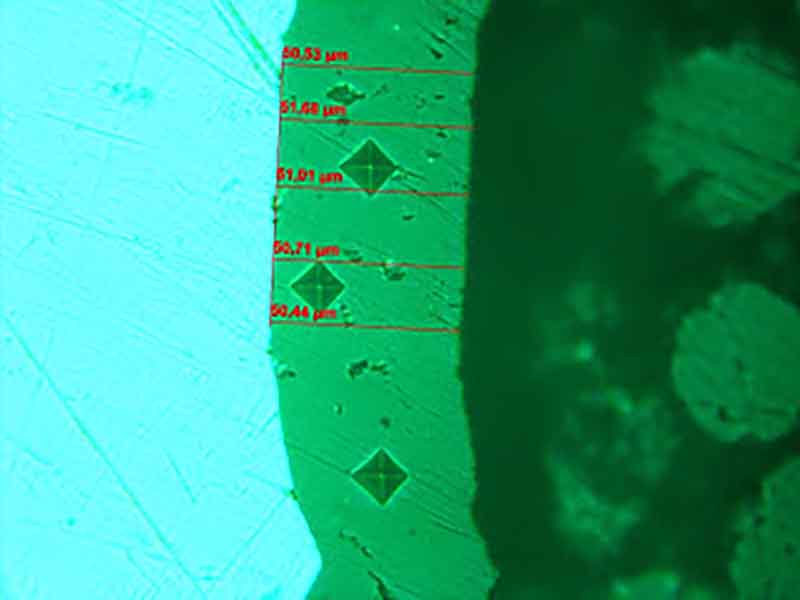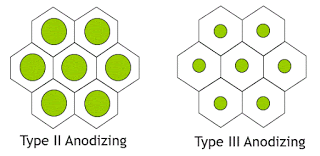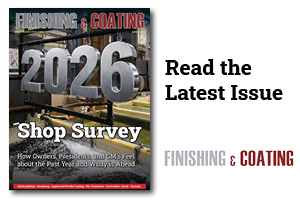Getting the aluminum product that you want means being clear about specifications.
If you have agreed with your anodizer to use hard anodizing, you should also agree on the hardness of your hard coat layer. In this article, you will learn how to define the hardness of hard coat anodizing.
What Is Hard Coat Anodizing?
Hard coat anodizing, also called hard anodizing or anodizing type III, gives you an even more corrosion-resistant surface than type II anodizing with a hardness of high-strength steel. Hard anodizing forms a dense oxide layer with thicknesses above 25 µm (1 mil). A dense oxide layer is an oxide layer with narrow pores and very thick cell walls. The figures show the differences in the structure of type II Anodizing compare to type III Anodizing. The anodized layer is seen from the top and down into the porous hexagonal structure.
Defining the hardness of hard coat anodizing: The structural difference between anodizing and hard anodizing.
Hard anodizing requires a low electrolyte temperature and a low concentration of the electrolyte in order to slow down the chemical dissolution of the oxide layer. Production of very thick coatings will usually involve very high voltages and/or high current densities, which lead to high local temperatures therefore agitation of the electrolyte is most important.
If you would like to learn more about hard anodizing, watch our free webinar recordings at AnodizingSchool. You will not only get an introduction to hard anodizing but also learn about the MIL-PRF-8625F (released November 2020, formerly MIL-A-8625F ) standard specifications and common defects that arise in the hard anodizing process. We will soon do a blog post about the changes between the standards.
How Hard is Hard Anodized Aluminum?
Following, you see the hardness comparison between different materials. What is so remarkable about hard anodizing is that it makes aluminum alloy four times harder. It is even 30% harder than stainless steel.
Material: Hardness (Vickers hardness)
- Untreated Aluminum Alloy 6082: HV 100 – 120
- Mild Steel: HV 200 – 220
- Stainless Steel: HV 300 – 350
- Hard-Anodized Alloy: HV 400 – 460
How to Define the Hardness of Hard Anodized Aluminum
The values are measured in (VPN) = Vickers pyramid number, also referred to as the Vickers hardness number (HV or VHN). The Vickers hardness is the amount of force applied to the diamond divided by the area of the indentation the diamond makes in the material; in practice, the diagonal of the pyramidal indentation is measured and the result is read from a table and is stated as an empirical measurement, without units. Other hardness measurement numbers are found, such as Brinell, Rockwell, and Knoops. The Vickers hardness is up to about HV 500 about 1.04 times the Brinell hardness but most of the time hardness of the anodic oxide layer is measure by Vickers.

Different hardness measures: Knoop and Vickers
Knoops hardness is almost identical to Vickers hardness except for the form of the diamond. In this testing method, the diamond has a rhombic-based pyramidal shape. The form of this indentation makes it possible to measure the hardness of aluminum oxide more accurately but it is still not widely used. The anodic oxide layer is very brittle and to obtain the best reproducibility of the measurements the Knoops diamond should be used. Using Vickers hardness measurements causes cracks in the oxide layer, so only measurements in the middle of the oxide layer are possible.
How to Test the Hardness of Your Hard Anodized Product
You should carry out the hardness test on anodic coatings on the edge of the film so that the effect of the underlying, soft aluminum is eliminated but not too close to the edge so the softness of the resin influence the results.
The image below shows a cross-section of a hard anodic coating with Vickers indentations and thickness measurements. The pyramid has to be square formed to be sure of the hardness value measured. The light blue to the left is the aluminum alloy and the dark to the right in the picture is the resin.

Cross-section of a hard anodic coating with Vickers indentations and thickness measurements
What Does The Mil-Spec Standard MIL-PRF-8625fFSay About Hardness?
The MIL-PRF-8625F standard or Military Specification says nothing about any requirements of the hardness of Type III, hard anodizing. The European Standard EN 12373 has none either. Both of them have on the other hand requirements of wear resistance of the coating. The maximum wear index for coatings on aluminum alloys having a copper content of 2 % or higher is 3.5 mg/1000 cycles and 1.5 mg/1000 cycles for all other alloys.
Would you like to learn more about anodizing for free? Join our knowledge community at AnodizingSchool and get access to free videos and other materials.

































